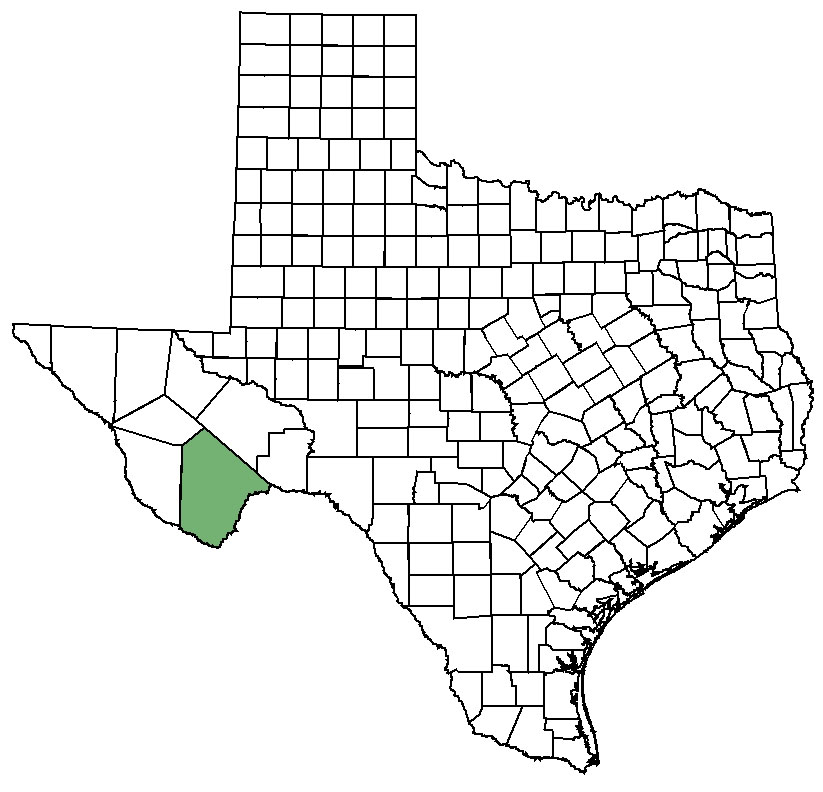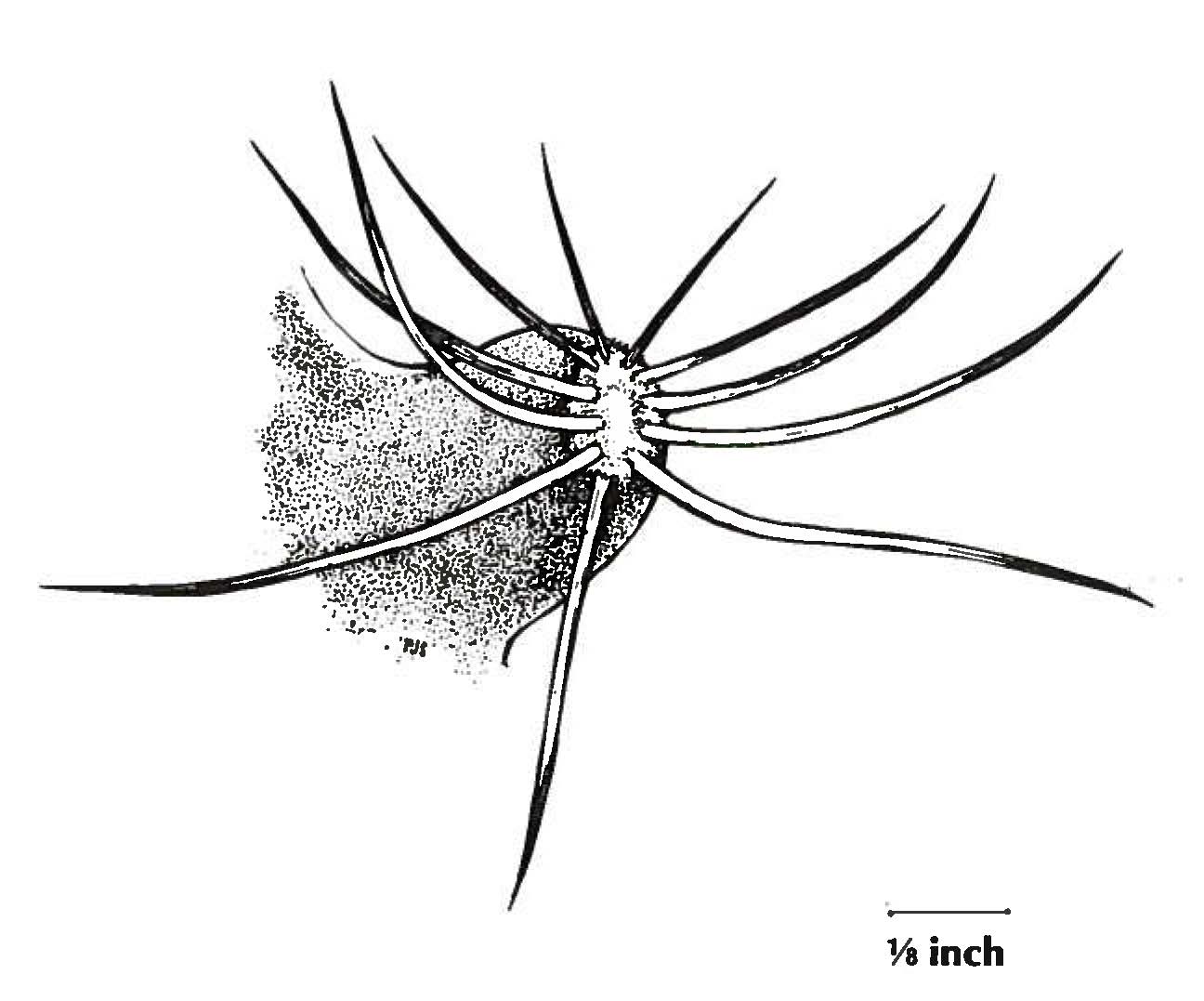Federal and State Listed Species of Texas:
Davis' green pitaya

Current
null
null
Distribution map of Davis' green pitaya (Echinocereus davisii).
- Scientific Name
- Echinocereus davisii
- Other Scientific Names
- Echinocereus viridiflorus var. davisii, Echinocereus viridiflorus ssp. davisii
- Other Common Names
- Davis’ hedgehog cactus, dwarf hedgehog cactus, Davis’ dwarf hedgehog cactus, Davis’ hedge cactus
- Status
- Federally and State Endangered
- Global Rank
- G1
- State Rank
- S1
Global Location
Davis' green pitaya is only found in West Texas in Brewster County.
null
Credit:
Description
Davis' green pitaya is a very small succulent perennial usually with solitary stems that are submerged almost entirely underground, though they can be up to 3.5 cm tall and 0.8 to 2.5 cm wide. Stems have 6 to 10 vertical ridges that are divided into spine-tipped cone-shaped projections. Spines arising from each of these projections are numerous and dense enough that at times, they hide the stem completely. Most of the spines, called radial spines, form a ring around the tip of the projection and are flattened against the stem. Occasionally a single reddish-purple spine arises interior to the radial spines. There are typically 8 to 15 radial spines which point up, down or sideways. The slightly stouter sideways-pointing spines are flattened and 11 to 19 mm long, The slightly thinner upward-pointing spines are 4 to 7 mm long. Flowers of Davis’ green pitaya are a tawny to greenish-yellow color. Fruits are 5.5 to 11 mm long and green with a red or muddy purple quality.
Davis' green pitaya is a very small cactus with solitary stems that are usually submerged underground.
Credit: Jackie Poole, Texas Parks & Wildlife Department

Davis' green pitaya has 8 to 15 radial spines — the illustration shows 11 radial spines. The slender upper spines are shorter, and the slightly stouter flattened and sideways-pointing spines are longer.
Credit: Patrick Stark, Texas Parks & Wildlife Department
null
Credit:
Similar Species
Davis' green pitaya is one of the smallest Echinocereus cacti in its range. The relatively few ridges, 6 to 10, distinguishes Davis' green pitaya from other related cacti.
null
Credit:
null
Credit:
null
Credit:
null
Credit:
null
Credit:
null
Credit:
Floral Characters
nullLeaf Characters
nullnull
Credit:
null
Credit:
null
Credit:
Habitat
Davis' green pitaya occurs on exposed areas of chert- or flint-like rock (novaculite) usually amongst spikemoss mats in Chihuahuan Desert shrublands.
Habitat of Davis' green pitaya.
Credit: Jackie Poole, Texas Parks & Wildlife Department
Life Cycle Events
Flowering occurs March to April and sometimes as early as February, fruiting shortly thereafter. During droughts the cactus may disappear by pulling underneath the spikemoss mats.
Survey Season
Davis' green pitaya is most easily found while in flower from March to April.
Citations
- Leuck, E.E. and J.M. Miller. 1982. Pollination biology and chemotaxonomy of the Echinocereus viridiflorus complex (Cactaceae). American Journal of Botany. 69: 1669-1672.
Additional Information
- Rare Plants of Texas
- U.S. Fish and Wildlife Service
- NatureServe: Echinocereus viridiflorus
- NatureServe: Echinocereus viridiflorus var. davisii
- Center for Plant Conservation
- Powell, A. M. and J. F. Weedin. 2004. Cacti of the Trans-Pecos and adjacent areas. Texas Tech University Press. Lubbock, TX.
- Poole, J.M. and G.K. Janssen. 1997. Managing and monitoring rare and endangered plants on highway right-of-ways in Texas. Section 6 final report. Austin: Texas Parks & Wildlife Department.
- McKinney, B.R. 2000. Rare plants, birds, mammals in the Trans-Pecos ecoregion of western Texas. Section 6 final report. Austin: Texas Parks & Wildlife Department.
- Westlund, B.L. 1991. Cactus trade and collection impact study. Section 6 final report. Austin: Texas Parks & Wildlife Department.
Comments
Bees see in a different visual spectrum than mammals — they see ultraviolet (UV) light instead of the red light visible to humans. Many flowers reflect UV light in various patterns only visible to insects that can see UV light. Davis' green pitaya is one of several species of cacti that have been studied to determine their UV patterns. Davis' green pitaya reflects UV light at the tip of their petals but not in the flower’s center (Leuck and Miller 1982). These UV patterns may provide the bee with a visual cue to direct them to nectar and pollen or allow the plant to stand out from the background landscape.